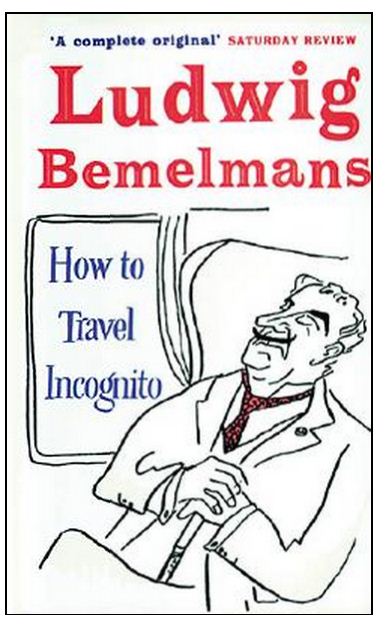My mother frequently reminded me we had some interesting relations, one of whom was the mad King Ludwig of Bavaria. “But how, what with our being Jews, could that be, Mom?” I asked. “I think he raped a peasant,” she replied. “The details have been lost to the sands of time.” If our family is, in fact, related to the mad king, I hope it is because of a consensual and pleasurable agreement between the peasant and the monarch. Ludwig Bemelmans would write it that way. He is a man who always chooses the pleasant story and the happy outcome in his dated but charming How to Travel Incognito.
How do you get by in Paris with no money? And not merely get by, but enjoy the best of service and relentless offers of luxuries? Simply pretend to be the Prince of Bavaria. Bemelmans, best known for the Madeline books, meets one Count of St. Cucuface on a train traveling through Europe. St. Cucuface generously teaches him how to be both a con man and bon vivant. (You might recognize the name Cucuface as that of the villain of the Madeline books. Bemelmans is happy to recycle funny names in the service of a good yarn.)
Bemelmans dedicates his “memoir” to a friend who suggested, one drunken night in Paris, that he “write something amusing, to cheer up the sorry world.”
Have you ever been annoyed by your spouse laughing while she is reading? Does she want me to ask her what made her laugh? Or is she so taken with some other fellow’s writing that she doesn’t want to include me? I’ve been annoying the hell out my husband, I’m sure. I can’t help it—the book is very amusing.
Bemelmans gets a lot of juice out of a simple premise: a man teaches another man him how to live well. Pretend to be the “Prince of Bavaria” and your broken umbrella will be mended without charge, and your meals will be served gratis and with side dishes to take home to your dogs. As for travel, St. Cucuface has it covered:
“There is a way of traveling cheaply in France. One simply gets on a train, sits down in a first-class compartment and falls asleep. There is a law in France that no first-class passenger asleep may be awakened by a conductor. They may awaken you in second or third class but never in first. Considering that we are a republic we have more regard for privilege than any other nation on Earth.”
You won’t care in the least whether or not Bemelmans is making this stuff up. (Obviously he is making most of this stuff up.)
How to Travel Incognito is also beautiful. The prose will be suddenly lovely, and then, as if embarrassed by its own elegance, it will nosedive into the droll.
“And within this triangle was all that is most beautiful in Paris. The moon was full, and the clouds were edged with the mauve and violet hues that Dufy smears into his pictures of the Paris sky. The beam of the searchlight atop the Eiffel Tower swept ceaselessly over the city and overhead could be heard the soft murmur of the throttled-down motors of a transatlantic plane.”
I must apologize to the Bemelmans family. I have always loved the Madeline books, as any sane person does, but I assumed the awkward scanning and rhyme reflected the author’s lack of acuity with words. Now I get it—Bemelmans is having fun when he rhymes “DAN-ton ten six six” and “appendix.” I blush to think how many years I missed the joke.
I don’t know whether my mother’s claim of our family connection to the mad king of Bavaria is true. (Neither does she.) Still, How to Travel Incognito reassures us that (sometimes) the story matters more than its veracity. (Sometimes) we must value the laughter a tale brings to the dinner table over a hard, dull bedrock of proof.




